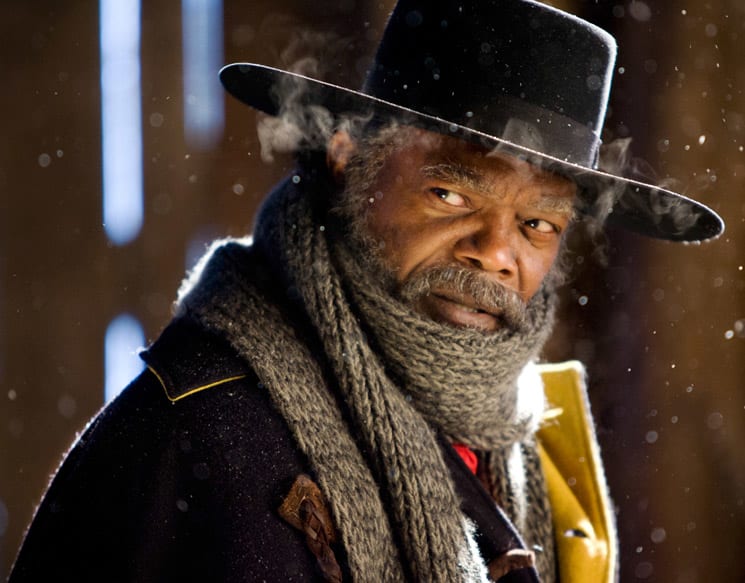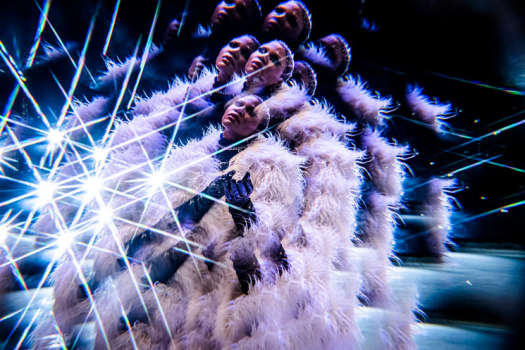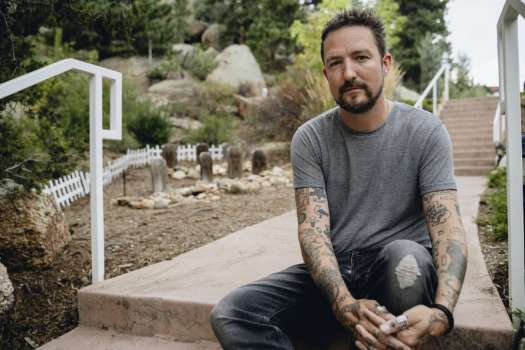Ever the nostalgic romanticist, Quentin Tarantino offers up his latest film, The Hateful Eight — his eighth in what he claims will be ten films — in several formats. Chiefly, a three-hour-plus 70mm "roadshow" version that features a six-minute overture (prior to the film, the score plays over the image of a stagecoach for several minutes, presumably warning the audience about what a protracted, indulgent ordeal they've inadvertently wandered into) and an intermission.
Like most of his films, which are chiefly pastiche (some call it "paying homage" while others call it lazy copycatting), he's harkening to the films of yesteryear with an antiquated cinematic experience with this presentation. It's noble and certainly makes a statement, but it's also a peculiar decision for a movie that is ostensibly a filmed stage-play with virtually no cinematic qualities. Save a well-considered and rather ominous opening tracking shot and the expected stylization of violence, The Hateful Eight is little more than an endless series of long-winded monologues delivered in two locations.
Before introducing the first set — a stagecoach housing bounty hunter John Ruth (Kurt Russell) and wanted criminal mastermind Daisy Domergue (Jennifer Jason Leigh) — the camera lingers on a partially snow-covered crucifixion with a mummified man hanging in a Jesus pose. It's not a subtle image, but it's one of the only calculated metaphors in the film and does aid in partially muting the nauseatingly bold misogyny persistent throughout. It also gives the audience something to think about when Daisy and John happen upon Major Marquis Warren (Samuel L. Jackson), a fellow bounty hunter and alleged friend of Abraham Lincoln known to have fought in the Civil War.
From here, this mostly nihilistic, survivalist take on the western mythology devolves into reckless Tarantino indulgence. Monologues go on for minutes at a time, doling out equal parts exposition and repetition, pointing out the obvious while delaying an overtly fatalistic trajectory that would have been served far better by imagery than endless, uninspired dialogue. To be fair, some of the one-liners are hilarious and the dialogue is occasionally moderately clever but, as is the standard in Tarantino fare, it's all written in the same voice with the same cadence and the same desperate plea for validation. When John, Daisy and Warren come across Sheriff Chris Mannix (Walton Goggins) and take him to a nearby shelter where elderly General Sandy Smithers (Bruce Dern), stoic cowboy Joe Gage (Michael Madsen) and prissy Brit Oswaldo Mobray (Tim Roth) are waiting out the storm, it's clear that every character is essentially Quentin Tarantino's superhero gussied up in superficial differences, such as race, age, colour and accent.
Once everyone is trapped in the humble single-room shelter waiting out the storm, there are some rather obvious hints at a twist, an expected and inevitable showdown. In the middle of the room is a chessboard, reminding us — in case the constant verbal reminders weren't enough — that everyone is withholding secrets and playing an elaborate game of social chess. In theory, a protracted mind-game played by a roster of shady characters could be a lot of fun, but since these characters are only their actions and the lies they tell don't really further the plot or complicate it with any substantive purpose, it's difficult to get invested.
Even when all is revealed, most of the back-stories have nothing to do with the speechifying and endless ego performance on display. It's disappointing, considering the degree of importance with which Tarantino presents everything and the presumably intentional protraction of every single character revelation. Since the cerebral component of The Hateful Eight is virtually null, we're left only with the constant barrage of shocking one-liners (although, by this point, n-word-laden rants in a Tarantino film are almost redundant) and endless gratuitous scenes of Jennifer Jason Leigh getting the shit kicked out of her to sustain attention.
It's not a secret that Quentin Tarantino struggles to write women — he often writes them as men or relegates them to victimized ciphers — but here, he presumably attempts to remedy that by making Daisy Domergue the craftiest of all characters. What seems pointed is the collective morality of the male characters when confronted with a woman of equally abject morality. Though everyone is little more than a self-serving killer, it's Daisy that the men all perceive as a nasty, irredeemable monster, and while it appears that this admittedly insightful observation about absurdist gender inequality is intentional (particularly considering the final images), it doesn't necessarily explain why the violence against men is so muted (it's even off-screen on occasion), while every scene of violence against Daisy is filmed with pornographic glee. Whether she's being clubbed on the head with a gun, punched across the face, chained to tables, getting her teeth knocked out or getting puked on, these physical attacks are played for comedy and shock, which actually gets quite nauseating by the time things reach the climax.
And considering that most of the discussions within the film are about the nature of executing and motivations for escorting a live bounty, the pointed imagery outlining gender divides and racial distinctions seems almost like an add-on to legitimize what is little-more than a childish, nostalgic male fantasy.
Another peculiarity is Tarantino's fetishized preoccupation with Samuel L. Jackson's penis. Throughout the film, "big black dick" is presented as a counter-cultural power symbol with interracial homosexuality present as comedy, framed as the ultimate denigration for a heterosexual white man. This decision, one that indirectly insults "the Other" by sheer merit of presenting it as an ultimate violation, reiterates the sort of indulgence already made evident by a script that's little more than a narcissist talking to himself for 180 pages. And though this isn't necessarily a flaw — Tarantino is staying true to what he knows and catering to a very specific, very male audience — it does make the pomposity of his overture and the superfluous nature of Catholic imagery almost laughable. It's also worth noting that the premise — wherein several men sit in a room together and mind-fuck each other while vilifying the lone woman, is exceedingly homoerotic, making the presentation of actualized desires as horrific and "funny" (as funny as rape can be) quite ironic.
While this style has (arguably) worked in past experiments, the lack of action and aesthetic variation in The Hateful Eight merely exacerbates its shortcomings. Quite frankly, this bout of misogynistic indulgence is boring. Perhaps with a little more stoicism (like that demonstrated in the films he's referencing here) and exploitation of film as a visual medium, some tension could have stemmed from the template, but as presented, this is little more than an exercise in tedium with rather rote observations about vengeance and a survivalist ethos.
(eOne)Like most of his films, which are chiefly pastiche (some call it "paying homage" while others call it lazy copycatting), he's harkening to the films of yesteryear with an antiquated cinematic experience with this presentation. It's noble and certainly makes a statement, but it's also a peculiar decision for a movie that is ostensibly a filmed stage-play with virtually no cinematic qualities. Save a well-considered and rather ominous opening tracking shot and the expected stylization of violence, The Hateful Eight is little more than an endless series of long-winded monologues delivered in two locations.
Before introducing the first set — a stagecoach housing bounty hunter John Ruth (Kurt Russell) and wanted criminal mastermind Daisy Domergue (Jennifer Jason Leigh) — the camera lingers on a partially snow-covered crucifixion with a mummified man hanging in a Jesus pose. It's not a subtle image, but it's one of the only calculated metaphors in the film and does aid in partially muting the nauseatingly bold misogyny persistent throughout. It also gives the audience something to think about when Daisy and John happen upon Major Marquis Warren (Samuel L. Jackson), a fellow bounty hunter and alleged friend of Abraham Lincoln known to have fought in the Civil War.
From here, this mostly nihilistic, survivalist take on the western mythology devolves into reckless Tarantino indulgence. Monologues go on for minutes at a time, doling out equal parts exposition and repetition, pointing out the obvious while delaying an overtly fatalistic trajectory that would have been served far better by imagery than endless, uninspired dialogue. To be fair, some of the one-liners are hilarious and the dialogue is occasionally moderately clever but, as is the standard in Tarantino fare, it's all written in the same voice with the same cadence and the same desperate plea for validation. When John, Daisy and Warren come across Sheriff Chris Mannix (Walton Goggins) and take him to a nearby shelter where elderly General Sandy Smithers (Bruce Dern), stoic cowboy Joe Gage (Michael Madsen) and prissy Brit Oswaldo Mobray (Tim Roth) are waiting out the storm, it's clear that every character is essentially Quentin Tarantino's superhero gussied up in superficial differences, such as race, age, colour and accent.
Once everyone is trapped in the humble single-room shelter waiting out the storm, there are some rather obvious hints at a twist, an expected and inevitable showdown. In the middle of the room is a chessboard, reminding us — in case the constant verbal reminders weren't enough — that everyone is withholding secrets and playing an elaborate game of social chess. In theory, a protracted mind-game played by a roster of shady characters could be a lot of fun, but since these characters are only their actions and the lies they tell don't really further the plot or complicate it with any substantive purpose, it's difficult to get invested.
Even when all is revealed, most of the back-stories have nothing to do with the speechifying and endless ego performance on display. It's disappointing, considering the degree of importance with which Tarantino presents everything and the presumably intentional protraction of every single character revelation. Since the cerebral component of The Hateful Eight is virtually null, we're left only with the constant barrage of shocking one-liners (although, by this point, n-word-laden rants in a Tarantino film are almost redundant) and endless gratuitous scenes of Jennifer Jason Leigh getting the shit kicked out of her to sustain attention.
It's not a secret that Quentin Tarantino struggles to write women — he often writes them as men or relegates them to victimized ciphers — but here, he presumably attempts to remedy that by making Daisy Domergue the craftiest of all characters. What seems pointed is the collective morality of the male characters when confronted with a woman of equally abject morality. Though everyone is little more than a self-serving killer, it's Daisy that the men all perceive as a nasty, irredeemable monster, and while it appears that this admittedly insightful observation about absurdist gender inequality is intentional (particularly considering the final images), it doesn't necessarily explain why the violence against men is so muted (it's even off-screen on occasion), while every scene of violence against Daisy is filmed with pornographic glee. Whether she's being clubbed on the head with a gun, punched across the face, chained to tables, getting her teeth knocked out or getting puked on, these physical attacks are played for comedy and shock, which actually gets quite nauseating by the time things reach the climax.
And considering that most of the discussions within the film are about the nature of executing and motivations for escorting a live bounty, the pointed imagery outlining gender divides and racial distinctions seems almost like an add-on to legitimize what is little-more than a childish, nostalgic male fantasy.
Another peculiarity is Tarantino's fetishized preoccupation with Samuel L. Jackson's penis. Throughout the film, "big black dick" is presented as a counter-cultural power symbol with interracial homosexuality present as comedy, framed as the ultimate denigration for a heterosexual white man. This decision, one that indirectly insults "the Other" by sheer merit of presenting it as an ultimate violation, reiterates the sort of indulgence already made evident by a script that's little more than a narcissist talking to himself for 180 pages. And though this isn't necessarily a flaw — Tarantino is staying true to what he knows and catering to a very specific, very male audience — it does make the pomposity of his overture and the superfluous nature of Catholic imagery almost laughable. It's also worth noting that the premise — wherein several men sit in a room together and mind-fuck each other while vilifying the lone woman, is exceedingly homoerotic, making the presentation of actualized desires as horrific and "funny" (as funny as rape can be) quite ironic.
While this style has (arguably) worked in past experiments, the lack of action and aesthetic variation in The Hateful Eight merely exacerbates its shortcomings. Quite frankly, this bout of misogynistic indulgence is boring. Perhaps with a little more stoicism (like that demonstrated in the films he's referencing here) and exploitation of film as a visual medium, some tension could have stemmed from the template, but as presented, this is little more than an exercise in tedium with rather rote observations about vengeance and a survivalist ethos.




